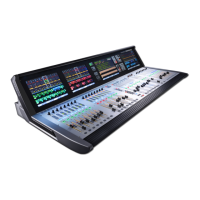6.5.3 6.5.3: INPUT CHANNEL > DYNAMICS > GATE
Vi3000 USER MANUAL
6.5.3: INPUT CHANNEL > DYNAMICS
Gate / DeEsser
Selection Field / Group: MODE Range Low Range High
Select either the GATE
or DeEsser function
for the rst dynamics
process.
The top line of dynamics controls adapt to this selection. Gate DeEsser
Gate Threshold
Set Field / Group: GATE Range Low Range High
Adjust the gate thresh-
old level.
-40dB +18dB
Gate In Field / Group: GATE Inactive Active
Include the Gate in the
dynamics signal path.
When Gate In is selected, the word 'GATE' is highlighted
in the touch screen dynamics section.
Out In
Gate Attack
Time Field / Group: ATCK Range Low Range High
Adjust the attack time of
the Gate.
10uS 957mS
Gate Duck
Function Field / Group: ATCK Inactive Active
Select the Gate DUCK
mode.
DUCK mode in inverse gate mode which reduces level
when the side chain input EXCEEDS the threshold. This
can be used for 'ducking' a music bed under a DJ vocal,
for instance.
Off On
Gate HOLD
function Field / Group: HOLD Range Low Range High
Adjust the Gate Hold
Tim
This is the time an activated gate will remain fully closed,
before entering the 'release' phase.
2.2 mS 2 seconds
Gate
A gate is a threshold driven gain reduction process normally used to reduce the level of, or silence, a signal when it
falls below the threshold. The gate section includes an assignable side-chain input with lters, a key signal solo func-
tion, and a ducking mode.

